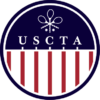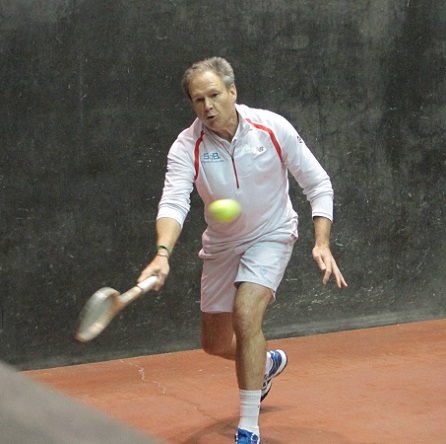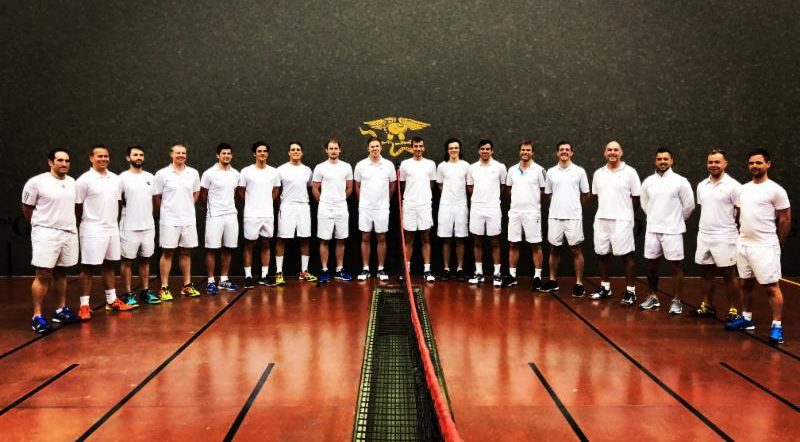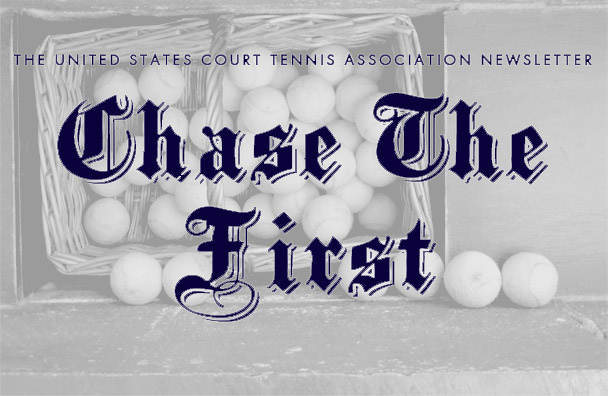A Note from the World Masters:
The Heart of the Matter
by George Bell
This is the story of a single frightening shot in an unimportant match. The ball struck and felled our opponent such that he lay on the floor flopping — but it is also the story of a reverie triggered by that blow, which brought back to me, slowly, as if summoned from a forgotten place inside, the pleasures that court tennis has offered me. Why such things should occur amid adversity is unknowable. In the days after the match, as our small caravan of competitors in the 60+ World Overs moved from Tuxedo Park to Philadelphia. And with the full recovery of our opponent (too quickly for my taste), the incident made me re-imagine court tennis as a community that is ever forming and breaking apart and reforming again, around the competitive events that punctuate our love of this antique game.
I say unimportant, but of course, the match was essential to the contestants. In the final team pairing of the Bostwick Cup, the UK faced off against the USA, both of us having defeated Australia. By the time Robbie McLean and I took the court to do battle with Paul Weaver and Duncan Colquhoun in the second doubles (and last match), the UK led 4-0 and had locked up the Cup. Still, there was an expectation of intensity and the game delivered on that — one of those occasions where everyone played well, and as happens for me sometimes, the out-of-body experience of joy in merely contending. Duncan was new to me. With the aura of a snowy-haired professor, he proved tidy and efficient with his strokes. He committed few unforced errors. I had faced off against Paul in doubles several times before, in New York and London, in the 50+ Worlds. When he takes the court, he is unassuming — slight, almost shuffling, with somewhat ungainly strokes. When play begins, he ranges over the court superbly and transforms into a reliable ball striker. This is all the more remarkable as, the day before when I was chatting to him in the Tuxedo pro shop, he told me he had suffered a major heart attack less than two years ago. Being a proper Brit, he covered the topic in a single, dismissive sentence, but you could tell it was traumatic and likely still never far from his thoughts.
The first set went to Duncan and Paul, but at 5-5 in the second set, the level of play had risen; Robbie McLean and I sensed our chance to draw even. During a long point, Robbie rifled a clean backhand from under the tambour toward Paul, who was guarding the chase galleries. The ball clipped the net cord, altered its path with only slightly diminished pace, and bore into Paul’s upper chest. He fell to the floor so quickly and utterly it was as if the marionette strings that held his small frame aloft had been severed all at once. We froze. Paul began to twist on the ground with pain, and shock, I suppose, given the stunning strike and the fact that it hit him square in the heart. I could see he wanted to stand up, a natural reaction as if standing would make everything better. I recall telling him to just lie there. I crossed over and saw his face grimacing, his hands clutching his chest. All three of us stood over him; Tim Chisholm, the Tuxedo pro and marker, gimped down the hall on his newly replaced knee and joined us. Now we were four in awe as if gathered to watch some experiment unfold at our feet.
I leaned down and took hold of Paul’s hand, which was shaking badly, and told him to take some deep breaths. After a few minutes, he got to his feet, sipped water, walked around a bit, and declared himself ready to go. He hit a few balls to make sure he was OK. Play resumed. Here’s the worst part — and I say this publicly so that my partner will have time to digest it before we next meet — I kind of felt myself rooting for Paul. On the next point, Robbie had two or three opportunities to hit for the galleries and score a chase, but he wasn’t going to put the ball anywhere near Paul so soon. I wouldn’t have either. By no means did we toss the game, but we lost it nonetheless, and the match. All over. Quick as that.
Afterward, I realized it was in the length of time I held Paul’s hand that triggered my reverie. In this country, heterosexual men don’t hold hands. But I had his in mine for what was, under any other circumstance, an awkwardly long period. It felt natural.
After the match, I drove to Hartford to meet my family, where Jimmy, the youngest of our three sons, was graduating from Trinity College. I was in a mood to sum things up, to think back a bit on my family, but also on court tennis. I would return to Masters competition after the graduation weekend, so we were far from done. Looking back is an unexpected pleasure of age. I had a period of intense love of court tennis, for six or seven years at the end of, and beyond, college. I split my time between squash and court tennis. We had a golden period in New York in the early 80s – Pete and Jimmy Bostwick were aging out of regular play, replaced by Gene Scott, Ralph Howe, Willie Surtees, Kevin McCullum, Simon Aldrich, Henry Bunis, and Randy Jones — with Morris Clothier in the ascendancy. We could put together great games at a moment’s notice, without email. We split up for Whitney Cup to balance out the teams. In those years, I played variously for Philadelphia, NY, Greentree, and NewBosTux. Despite my father and grandfather’s enthusiasm for our game — they were both Presidents of the Racquet Club of Philadelphia and champions there — I pretty much walked away from the game after that period in New York. I didn’t touch a racquet for nearly twenty years. I realized it had been almost thirty years since I had last visited Tuxedo, staying then, as now, with my friend Archie Gwathmey, re-visited by happy memories of Gold Racquet weekends long ago.
No incident precipitated my split with the game. My work as a young producer and writer of adventure documentaries for ABC Sports took me to the mountains, jungles, and oceans of the world for long periods, maybe six months a year in aggregate, so hanging onto an active calendar of court tennis and squash fixtures was getting harder. Occupational hazards, such as intestinal worms, malaria, and coral cuts that refused to heal, didn’t help either. Then I moved to Los Angeles to expand my writing career in television, but really for a woman (ended badly). After four years, I moved back to New York for another woman (who made my second marriage the great achievement of my life). Another career change, a move to Long Island, the birth of our first two sons in Manhasset, near Greentree (where I still played occasionally on Sunday mornings with Pete Bostwick, Robert Pilkington, and others); a family move to Silicon Valley for yet another career, our son, Jimmy, born in Palo Alto. Buying and renovating; only to later sell and move on from homes in New York City, Los Angeles, Long Island, San Francisco. Five years turns to twenty. Those blessed bats I used to re-grip at night — do I even own court tennis racquets anymore?
This is all sounding too much about me when in fact I’m seeking to sketch the common lines of our relationship to court tennis. Let me shorten the explanation of my long absence from the game. It was driven by career mostly, but a quantifiable part was also later-age rebellion. Living twice on the west coast made me see our game as many outsiders do — an infinitesimally small, happy distraction for the 1% of the 1% of our population who sally into and out of private clubs with no more thought than entering or exiting a sandwich shop. Sheepishly, I looked back at our 1980 VanAlen Cup team trip to Europe, with Peter Vogt, Jimmy Knott, and Steve Loughrin, as an extended series of clubby dinners and bar-crawls behind velvet ropes, interrupted by court tennis matches. In the rearview mirror, I freighted our game with too much privilege and false polish. At the time, I was CEO of Excite, one of the first of the internet’s search engines, based in the heart of Silicon Valley. The neighborhoods of Menlo Park, Atherton, and Palo Alto, once walnut and fruit farms, began to vibrate with incoming entrepreneurs, venture capitalists, engineers, and bankers. The consumer internet was birthing on the front page of the NYT and the WSJ daily. We would democratize knowledge, put all of the world’s citizens on equal footing. Our status symbol du jour was a tiny, black Motorola flip-phone, the size of a billfold, with an antenna. For those of us in the swirl of it, the anything-is-possible ethos of Silicon Valley became a belief, a creed.
Then we returned to the east for good — this time to Boston, my wife’s ancestral home, not Long Island — after the first internet bubble burst. For the first few years, I didn’t rejoin the T&R there. My time with the game seemed behind me in some way. I found myself yearning to go back into the building, recalling it as marvelously decrepit, thinking about the games I played there after my squash season had finished at Harvard — games with Phil Stockton, Dev Hamlen, Dick Brickley, and Chuck Libby. Helping train our then-pro Barry Toates for his World Challenge against Chris Ronaldson. Where were they all now?
You open a door, goes the phrase. I found my way back to court tennis because I missed the satisfaction of a ball well struck (better than lawn tennis or squash), the competition, the easy companionship of my fellow players. Oh, and the appeal of whacking a ball around in a cave. One other important thing that I had buried: it’s a rare part of my life in which relationships have endured over significant periods; and one feels welcomed back, after a prolonged absence, by merely showing up again. I guess we’re a fragile bunch that way, looking to add to our ranks.
When I got to Philadelphia this week to compete in the 60+ World doubles with my partner Simon Aldrich, I was struck again by this pattern of absence and return. I hadn’t been to the club in maybe 25 years, yet I used to be there regularly when I was home from college on Christmas break. In the large building, I knew all the back stairways and shortcuts as if it were yesterday. Outside the court on the third floor, I walked the halls lined with old black and whites, Whitney Cup teams, visiting teams, father-son teams. I found pictures of my grandfather, John Bell, from the 1930s; pictures of my dad, George Bell, in the early 50s, dressed in suit and tie, pressed into a semi-circle on court with his fellow winning Whitney Cup team members, the redoubtable Jimmy Dunn, then a young pro from East Falls, squatting in the foreground with a basket of balls. I saw pictures of my dad and me alongside other father-son pairs, recalling our years playing that tournament together in the mid-1980s. He would die young, my dad, of pancreatic cancer, quickly, when I was 35, a week before the birth of our first child, a boy, who we knew instantly we would name George in his memory.
All the while, the dedans was populated with my fellow 60+ competitors, cheering on the contestants in our second week of matches, vaguely mindful that we have grown frailer. During our fortnight, two players threw out their backs, one injured his hamstring and had to withdraw, and Tasmania’s Graeme Bradfield received 24 stitches after a bike fall in Tuxedo Park but returned to play. Between matches in week two, the Preservation Foundation had arranged for us to have discounted access to a liquid vitamin infusion.
I realized that I don’t know much about many of the visiting players in our competition, but I’ve known them over time, and there is a depth in that as I grow older. Jon Prenn, the good-as-new Paul Weaver, Jon Hamer from Melbourne. My US teammates. As to the international players, we are not likely to see each other soon; in fact, it may be years before we meet again. Absence and return; but we will see each other again, on weaker legs no doubt. We will trash-talk, share our inventory of injuries, report on our children, and our retirements. And then we will play court tennis, fiercely and joyfully, ready to pick each other up off the court, if ever it is needed, so that we may continue.



